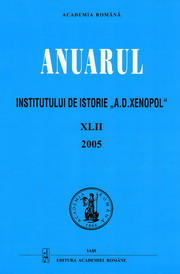ÎNCĂLCĂRI ALE DREPTULUI DE CTITORIE: PROCESELE DEZÎNCHINĂRII MĂNĂSTIRII PRECISTA MARE DIN ROMAN (SECOLELE XVIII−XIX)
VIOLATIONS OF THE FOUNDATIONAL RIGHT: THE TRIALS OF UN-DEDICATING THE PRECISTA MARE MONASTERY IN ROMAN (18th−19th CENTURIES)
Author(s): Mihai MîrzaSubject(s): History
Published by: Editura Academiei Române
Keywords: Precista Mare Monastery; St. Spiridon Monastery; bishop Ioanichie from Roman; foudation right; hospital; Ştefan Racoviţă
Summary/Abstract: An important way of displaying piety, power and social prestige, the foundational act as a historical phenomenon in the Romanian Principalities raises particular interest. Contributions so far, quite numerous at first sight, are far from exhausting a topic which proves complex and, often, controversial. The article seeks to support this claim, as well the fact that the foundational act is a topic still open to new research in Romanian historiography. Starting from a set of unpublished documents – eight of which are printed in the Annexes – the author retraces the consequences of the dedication of the Precista Mare Monastery from Roman to the St. Spiridon Monastery in Iaşi. The dedication was made by Ştefan Racoviţă, the ruler of Wallachia, on September 7th 1764. His decree was based on the foundational right inherited from his brother with the purpose of using funds from Precista Mare’s huge fortune to support works at the hospital built at Constantin Racoviţă’s initiative in the yard of the afore-mentioned Iași monastery. It was concluded that the dedication was made abusively, without asking for the other founder’s (bishop Ioanichie of Roman) consent, despite him still being alive, and without considering the directives in the other founder’s will, Constantin Racoviţă, who forbade any type of dedication of his church to another monastery or religious foundation in Moldavia or elsewhere. The analysis of the sources shows that Grigore Ghica (III), ruler of Moldavia, the one who checked and approved Ştefan Racoviţă’s document, rather looked for arguments to support dedication, attempting to placate the bishop’s indignation. The latter’s protestations delayed the confirmation of the dedication act significantly and determined the ruler of Moldavia to reach a compromise so that the dedication would be accepted by the bishop. To reach his goal, the ruler conceded some points that violated a few of Ştefan Racoviţă’s foundational act specifications to the representative of the high clergy. Thus, after a few months’ negotiation, the bishop agreed to the dedication without giving up managing his church, which was expressly mentioned in the first confirmation act from November 20th, 1764. Another three confirmation acts followed, issued by the same ruler, in the following eighteen months, since the solution proposed by Grigore Ghica (III) as to the relations of subordination between the Precista Mare and the Sf. Spiridon monasteries proved unviable, poisoning the relations between the bishop and the Sf. Spiridon churchwardens. The dedication act was contested and attacked at the Court Council two decades later by Ioniţă Racoviţă, brother of Ştefan Racoviţă, with the support of his nephews, the children of dragoman Mihăiţă Racoviţă. The trial they started with the trusteeship of the Sf. Spiridon Monastery was judged by their relative, Alexandru C. Mavrocordat Delibey and ended with the removal of the Precista Mare Monastery from the tutelage of the Sf. Spiridon Monastery. In less than a year, in the spring of 1785, the successor of the very same ruler, Alexandru I. Mavrocordat Firaris, also called Pârlea vodă, annuls the decision, re-dedicating Precista Mare to Sf. Spiridon. Although they lacked the stamina to successfully contest the dedication, the Racoviţă family kept a vengeful attitude towards the trusteeship until late in the nineteenth century, some of them enjoying life-long compensatory annuities. Their claims were justified since the Precista Mare Monastery held up all their family’s land, which had been given away by Constantin Racoviţă in 1757 without having consulted with his brothers, who had an equal right to inherit the family fortune. The people involved, the genealogic connections between them, the nexus of motives, the political and familial solidarities, as well as the political context in which decisions were made are all explained to the effect of explaining the context in which the dedication was made and the contradictory rulings made by the monarchs. It can thus be seen that the dedication also had hidden purposes running alongside the obvious ones which might have come first at the time of the dedication.
Journal: Anuarul Institutului de Istorie »A.D. Xenopol« - Iaşi
- Issue Year: LII/2015
- Issue No: 52
- Page Range: 101-153
- Page Count: 53
- Language: Romanian

